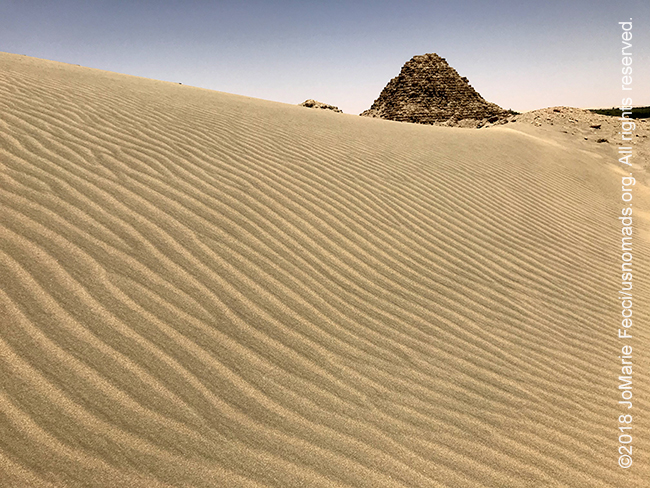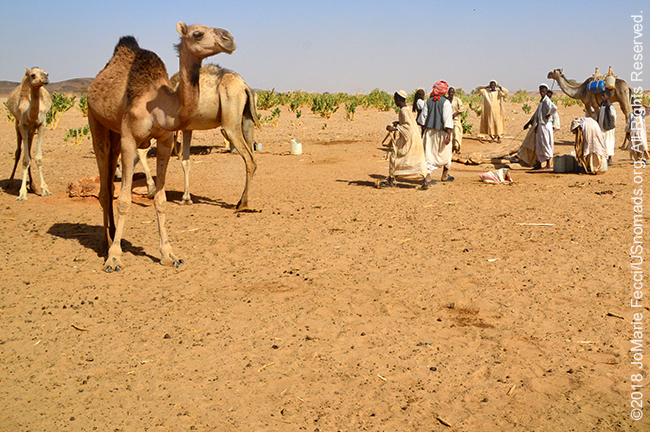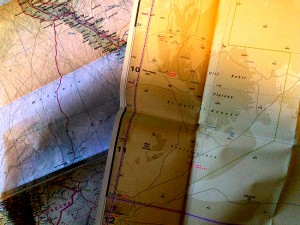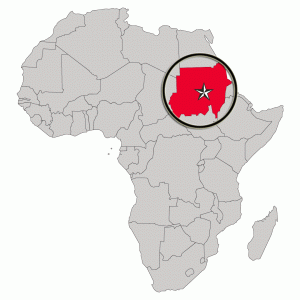
BAYUDA DESERT, SUDAN (10 April 2018) — We headed back into the desert today crossing from the Nile to the Nile on the old route. One of the interesting things about traveling here is that it is actually possible to go from the Nile on the west to the Nile on the east to the Nile again still further east because of the way the river winds its way through the desert in a large s-curve. It can confuse navigation a bit until you see it clearly on a map.
We started out early from Karima even though we had had a late night at the guesthouse chatting with Sami’s friends and colleagues. This morning we had a lot to accomplish, starting back at the pyramids below Jebel Barkal. The light was beautiful and the structures had a perfect glow. Turning my back to the road it seemed like the middle of the desert. Beyond the pyramids and closer to the holy mountain were the temple ruins.
We wandered around their grandeur undisturbed. We were the only ones there. Though Sami said there are some major festivals in this place and the ambiance is totally different with crowds and chaos, for now they were hauntingly empty. Some of the temple interior wall paintings had been restored and in other places artifacts had been excavated only to be reburied once they were cataloged. This seemingly counter-intuitive process is designed to preserve them until there is a plan and resources in place to protect them uncovered. Sami mentioned that the workers who had done the digging were not very happy when afterwards they were told they had to fill it all back in, and I could imagine how they must have felt like the whole project had been a kafka-esque “make-work” assignment.
In places it was hard to tell where the temple ended and the mountain began, as if the two were a single edifice. Maybe part of the temple was actually cut into the mountain. Columns the same color as the mountain seemed to rise from the sand as if they grew there, or were actually rock spires. The whole area was a complex of temple ruins that sprawled into the pyramid tombs, mixing the living and the dead and the gods and the royalty all together in a single monument.
It was easy to reflect on the past and ponder the civilizations that left us this remarkable heritage. The desert preserved it’s message and their history. I appreciated the ease with which we could visit and commune with antiquity here, without all the artifice of mass tourism. I preferred being able to experience the reality of the ruins (although even in these places where it seems in its natural state, it has been “manicured” and “designed” experientially — Sami explained that his teams worked to remove piles of debris from previous excavations to make the sites accessible, and arranged the landscape somewhat so that visitors would follow a “path” of sorts, but all in a very under-stated way, allowing for this feeling of “discovery” as you naturally approached each site of ruins from the “easiest” way without need for signs and barriers. I really liked this more discrete way of curating the experience. But perhaps it is only possible because these sites do not see the numbers of tourists that descend on Egyptian or Greek ancient monuments. In any case, I was enjoying the sensation of “discovery.”)
When we left the area of Jebel Barkal we made a short detour to an area of the desert I had noticed yesterday evening that resembled the terrain of the southwest of the USA with a series of hidden canyons between low hills so similar to parts of Anza Borrego. There was no time to really stop and explore there but I had hoped to be able to get some good photos at least. The light was less than perfect. I looked longingly down the length of one canyon after another, wishing I could have more time. It would be easy to just come and spend some weeks in only the Karima area and still not be able to explore it all.
We had to keep moving, modern nomads propelled by a time limit. Before leaving Karima completely, we drove to a site in the middle of “nowhere” marked only by the presence of a white Toyota pickup with the logo of the Sudan Antiquities department. This was the site of a very small archeological investigatory dig being led by the Director of Antiquities for the region. There were some ancient tombs being excavated, investigated and then re-covered to protect them. The tombs were of interest because of the likelihood that they contained the remains of some prominent individuals, and yet were not in the same necropolis as their contemporaries. It was curious and unusual, and so of interest to researchers trying to piece together details of ancient history. For me it was also interesting to see the process firsthand as a small team helped carefully dig down into the tombs by hand with small shovels and brushes so as not to damage the structures or artifacts. It was not the glamorous image we have in mind of archeologists at work, but rather a very real depiction of how they do what they do. While major excavations might have teams of workers, this kind of low key investigation was conducted entirely by a handful of professionals doing all the work themselves.
I was very honored to be able to visit the site and observe the process, and for a moment felt like a graduate student again, as I listened carefully to the detailed explanation of the questions they were trying to find answers to and why they were important. The search for knowledge. The archaeologists were searching in history and I was searching in the desert’s metaphysical self. The Sahara holds its secrets from us all, only sharing them when the time is right.
As we left the dig site I was deep in thought about the links between ancient and modern and the CSI-like nature of these investigations into history. What makes some ancient things interesting to the archaeologists while other ancient things are just old and forgotten and no one cares? I kept thinking back to Sai Island and the layers of sites and the fact that we were walking on pottery shards crushing them beneath our feet and that was “ok”. Thinking further back to Algeria and the Tassili and the rock art that was too “ordinary” to even be pointed out — that same etching would be a major “site” in another location, but wasn’t considered important enough when surrounded by so many more artistic and interesting examples of the form.
My thoughts were quickly interrupted by the sight of more pyramids in the desert alongside the road. They were in various states of crumbling back into the sand. A few were still magnificent majestic structures imposing into the sky and demanding attention. Others were almost completely covered and just seemed like small hills. The necropolis was huge. There were hundreds of pyramids there. We stopped to walk among them — communing with the spirits of the ancient dead as the wind blew fine grains of sand between the man-made monuments. Looking at one of the smaller crumbling pyramids, I could almost see its form as simply a pile of rocks and I wondered if the origin of the great pyramids was a stylized version of a simple pile of rocks to mark a grave. As we walked about alone in the desert, I realized we were not actually alone. From seemingly nowhere a white robed man was now walking towards us. He turned out to be the caretaker and he had a cardboard map of sorts that cataloged the location of each pyramid on the site. After we explored for a while he invited us into the shade of some palm trees from under whose shadow he had emerged. That was something else I was learning here. When you think you are all alone in the middle of the desert you probably aren’t. There is a nomad somewhere sheltering in the shade of a rock ledge or a few palms or really anywhere the desert creates shadow. We look out across the desert and we don’t see the people watching intently from their shaded refuges. But they always see us. They know how to observe movement from miles away. They hear a truck’s motor and sometimes they will know what kind of vehicle it is even before ever seeing it. We are “blind” in comparison. And then I wonder how they would handle the chaos of a modern city with so much movement and noise everywhere — would they be as lost as we are in their desert?
We took our leave of the caretaker and the pyramids and continued on into the Bayuda Sahara — the “white desert”. Unlike Egypt’s “White Desert” where there are actually snow-white rock formations, the Bayuda Sahara is a normal sandy desert, where I suppose the sand is a bit “whiter” than in some other parts of the nearby Sahara. I remembered how the Tuareg taught me about navigation by the color of the sand, and imagined that the name “white desert” had a significance here. The pistes were good and well used and the terrain alternated between flat sandy stretches and low rocky hills. There were occasional acacia trees and small bushes making it a somewhat hospitable part of the desert, and perhaps because of that there were nomadic herders living around the area.
We stopped to visit a few of the families as we followed our route heading east. One elderly man was alone in his small “compound” of shelters constructed with found materials. The structures were sparse, and I thought it strange that they would build such small rooms when they had the whole open desert as their canvas. But even in their buildings, the nomads are efficient and economical, not wasting anything, not even space.
As we chatted over fresh brewed coffee, we looked at some photographs of his large extended family and the talk turned to the weather and the availability of food for the animals — the concerns of daily life here. During our visits we distributed some packaged food and basic over-the-counter medicines, and translated the instructions for usage of each. We also made stops at wells along the route where people were getting water. At one well we came across a father and his sons moving a herd of camels. The men and boys were watering the animals when we pulled up, and after some friendly chatting, the father asked us if we could help them. It seemed that one of their camels had just died. It had seemed healthy, but then just fell dead right near the well. No one knew what caused it, though they suspected that it had been a camel tick. And the problem was now, what to do with the dead camel. With its sudden and unexplained death, it could not be safely used for meat, and it was so close to the well they feared it could contaminate the water. Pointing to our Toyota, the father asked us if we could tow the it out into the open desert away from the communal well.
Of course we agreed, and so we pulled up to where it lie, and one of the sons rigged it up, and we towed the dead camel a few hundred meters into the desert beyond. It was a strange scene. The unfortunate animal’s body was left unburied so the desert scavengers could do their part in the cycle of life. The men thanked us, and returned to their herd, as we took of in the other direction continuing eastward towards the Nile.
The sun was low in the sky when we decided to camp near a hill of boulders that would block the wind. A few accacia trees stood off in the distance. It was a bit cooler, and I went for a walk, randomly following no particular path, just enjoying the beauty of the desert, then slowly I climbed to the top of the boulder hill to watch another magnificent sunset …

ABOUT THE EXPEDITION

JoMarie Fecci, of USnomads, sets off on an independent scouting trip across Egypt and Sudan in preparation for an up-coming Sahara expedition. Driving locally-sourced Toyotas and working with small local teams in each region, she will traverse a winding route that jumps off from key points along the Nile as far south as Khartoum, where the Blue and White Niles meet. During the journey she will visit a series of UNESCO world heritage sites focused on the ancient civilizations that occupied the region and meet with local communities. The primary goal of this mission is to assess terrain, security, driving conditions, logistical concerns and approximate timeframes for future travel.
WHERE WE ARE

The Sudan in Northeast Africa is bordered by Egypt to the north, the Red Sea, Eritrea and Ethiopia to the east, South Sudan to the south, the Central African Republic to the southwest, Chad to the west and Libya to the northwest. The country has a total area of 1.861.484 square kilometres (718.722 square miles), making it the third largest in Africa. The terrain is generally flat plains, broken by several mountain ranges. In the west the Deriba Caldera (3,042 m or 9,980 ft), located in the Marrah Mountains, is the highest point in Sudan. In the east are the Red Sea Hills. The name Sudan derives from the Arabic “bilād as-sūdān” or “the lands of the Blacks.” The population of roughly 37 million people is made up of 597 different ethnic or tribal groups speaking over 400 different languages and dialects. Sudanese Arabs are by far the largest ethnic group, estimated to account for 70% of the population. They are almost entirely Muslims. The majority speak Sudanese Arabic, with some different Arabic dialects, while many Arabized and indigenous tribes like the Fur, Zaghawa, Borgo, Masalit and some Baggara ethnic groups, speak Chadian Arabic. The nation’s official languages are Arabic and English. Sudanese history goes back to Antiquity, when the Meroitic-speaking Kingdom of Kush controlled northern and central Sudan and, for nearly a century, Egypt.